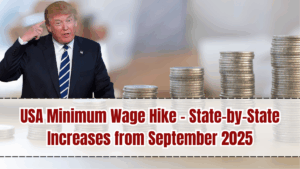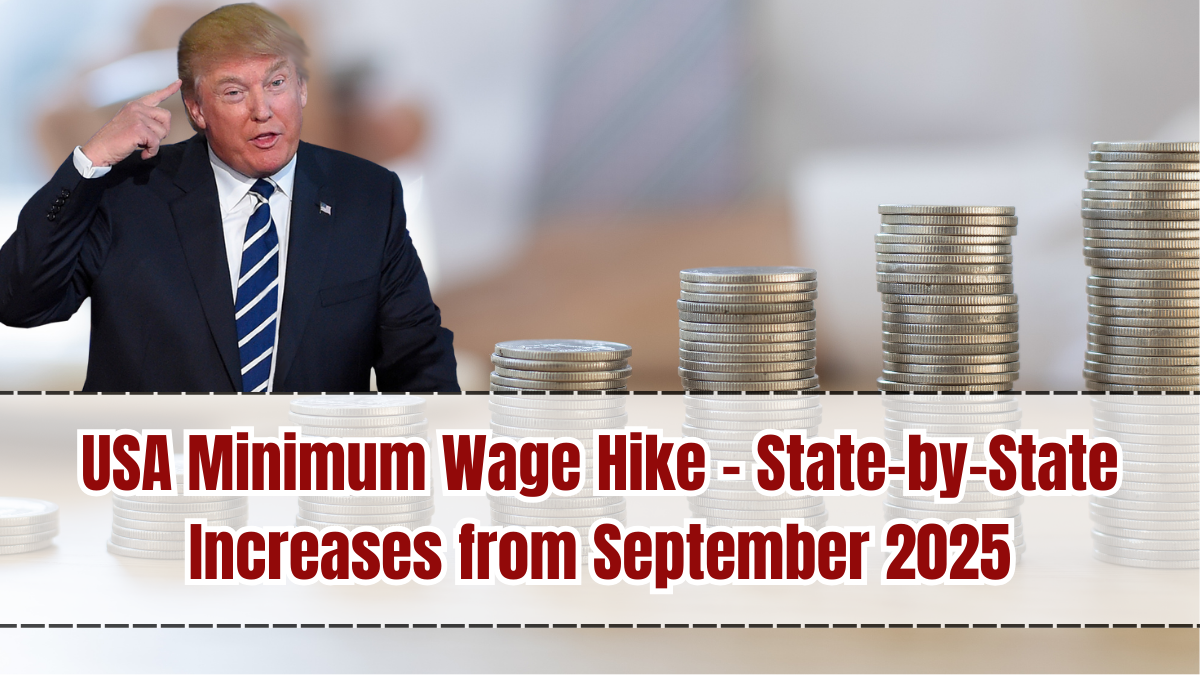Workers across the United States are set to see pay rises as part of the USA Minimum Wage Update 2025, which takes effect in September 2025. Multiple states have confirmed adjustments to their minimum wage levels, reflecting inflation, cost of living pressures, and ongoing labor market reforms. The state-wise increase is designed to provide fairer pay for workers in low-wage sectors while keeping local economies competitive.
This article provides a breakdown of the changes, explains which states are affected, and discusses what this means for employees and businesses nationwide.

Why Minimum Wages Are Rising
The push for higher wages comes from several economic and social factors:
-
Inflation: Rising living costs have made current wages insufficient for many households.
-
Labor Market Pressures: Worker shortages in hospitality, healthcare, and retail have increased calls for fairer pay.
-
Policy Reform: State legislatures and ballot initiatives continue to drive wage reform in the absence of federal increases.
-
Income Equality: Advocates argue wage hikes reduce poverty and narrow the gap between low- and high-income earners.
With the federal minimum wage stuck at $7.25 since 2009, state-led action has become the main driver of reform.
States with Confirmed Wage Increases – September 2025
Several states have announced new minimum wage levels effective September 2025. Below are the highlights:
-
California: Rising to $17.50 per hour, one of the highest in the nation.
-
New York: Increasing to $16.50 per hour in New York City and surrounding counties, $15.50 in upstate regions.
-
Washington: Moving to $16.25 per hour, adjusted for inflation.
-
Oregon: Rising to $15.75 per hour, with regional adjustments.
-
Illinois: Increasing to $15.25 per hour.
-
Florida: Continuing its annual hike toward $15, with a new rate of $14.50 per hour.
-
Massachusetts: Raising the wage floor to $16.00 per hour.
-
Texas (selected cities): While the state minimum remains $7.25, cities like Austin and Dallas are implementing local ordinances raising wages for municipal workers to $15.00.
Other states including Colorado, New Jersey, and Arizona are also introducing smaller adjustments tied to inflation indexes.
How the State-Wise Increases Work
Each state uses a different model for wage setting:
-
Indexed to Inflation: States like Washington and Arizona automatically adjust wages each year based on inflation.
-
Legislative Mandates: States such as California and Massachusetts pass laws with step-by-step increases.
-
Ballot Initiatives: In Florida, voters approved gradual wage increases via referendum.
-
Local Ordinances: Cities and counties in low-minimum-wage states often create their own rules for fairer pay.
This patchwork system means workers’ wages vary significantly depending on where they live.
Impact on Workers
The USA Minimum Wage Update 2025 is expected to benefit millions of employees:
-
Higher Take-Home Pay: Workers in retail, hospitality, and care industries will see meaningful wage boosts.
-
Reduced Poverty: Wage hikes help households cover rent, groceries, and healthcare.
-
Greater Financial Security: Increases improve retirement savings and reduce reliance on government aid.
-
Better Job Retention: Fairer pay encourages workers to stay longer in roles, reducing turnover.
For many low-income families, the changes mark a step toward greater stability.
Impact on Employers
While beneficial for workers, wage increases pose challenges for businesses:
-
Higher Operating Costs: Particularly in industries with slim margins like food service.
-
Price Adjustments: Some companies may raise prices to offset labor costs.
-
Automation Pressure: Employers may adopt technology to reduce reliance on staff.
-
Competitive Advantage: Fairer pay may attract and retain skilled workers, reducing recruitment costs.
The long-term effects on businesses will vary by sector and region.
Broader Economic Implications
The September 2025 state-wise increase also affects the broader economy:
-
Consumer Spending Growth: Workers with more income spend more locally.
-
Reduced Inequality: Wage hikes help narrow the income gap.
-
Inflation Risk: Some critics warn that wage hikes could fuel price increases.
-
Federal Policy Debate: State reforms may put pressure on Congress to revisit the federal minimum wage.
Overall, economists believe the positive impacts outweigh potential drawbacks if wage hikes are managed effectively.
Preparing for the Wage Changes
Employees and employers alike should prepare for the September transition:
-
Workers: Check official state announcements to confirm the new hourly rate.
-
Employers: Update payroll systems to comply with new wage laws.
-
Small Businesses: Seek government grants or tax relief programs to offset costs.
-
Tenants and Consumers: Be prepared for possible small increases in service prices.
Being proactive ensures compliance and smooth adjustment for all parties.
Conclusion
The USA Minimum Wage Update, taking effect in September 2025, marks another milestone in the movement toward fairer pay across America. With states like California, New York, and Washington leading the way, millions of workers will benefit from higher hourly wages. While businesses face challenges in adapting, the long-term benefits of reduced poverty, stronger consumer spending, and fairer labor markets make the reforms essential. The patchwork of wage laws may vary by state, but the direction is clear—higher wages are here to stay.
FAQs
When do the new minimum wages take effect?
They begin in September 2025 in multiple states.
Which state will have the highest minimum wage?
California, at $17.50 per hour.
Will the federal minimum wage change?
No, the federal rate remains $7.25, but many states set higher minimums.
How does this affect small businesses?
They may face higher labor costs but can benefit from better staff retention.
Are local wage increases included?
Yes, cities like Austin and Dallas are implementing local wage ordinances.
Click here to know more.




